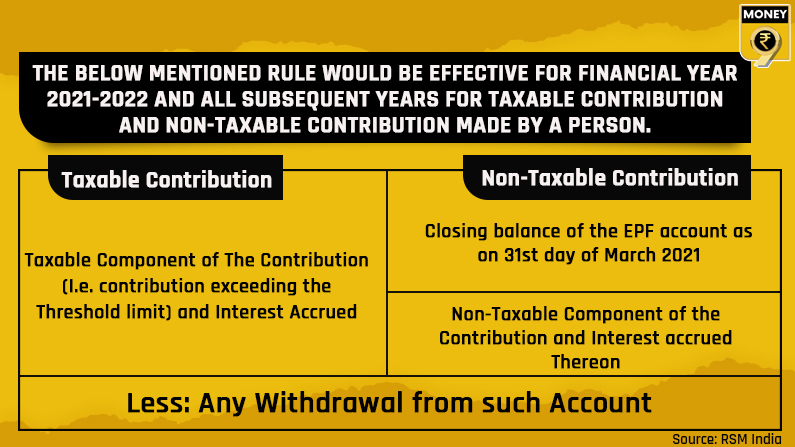You may need two separate accounts within EPF from this fiscal year
Rule 9D provides for separate accounts to be maintained within the provident fund from this fiscal year
- Himali Patel
- Last Updated : September 8, 2021, 17:31 IST

Those contributing more than Rs 2.5 lakh to the Employee Provident Fund (EPF) in a fiscal year, will have to keep two sepatate accounts from FY22, the Central Board of Direct Taxes (CBDT) has notified.
“For the purpose of calculation of taxable interest under sub-rule (1), separate accounts within the provident fund account shall be maintained during the previous year 2021-2022 and all subsequent previous years for taxable contribution and non-taxable contribution made by a person,” the CBDT notification said.
The CBDT circular dated 31 August has led to many ambiguities among the EPF subscribers. EPF, for long, enjoyed the EEE (exempt-exempt-exempt) status. However, the Union budget 2021 had stipulated that interest earned on EPF contributions exceeding Rs 2,50,000 would be taxable.
However, in certain cases where only the employee is contributing, the threshold has been doubled to Rs 5,00,000.
“The CBDT via Notification No. 95/2021 notified Rule 9D which provided for the manner of computation of taxable interest relating to contribution in a provident fund or recognised provided fund, exceeding specified threshold limit as aforementioned. Rule 9D provides for separate accounts to be maintained within the provident fund account with respect to the taxable as well as a non-taxable contribution,” said Suresh Surana, Founder, RSM India.

Having said so, the rule would be implemented from the fiscal year 2021-2022 and following years for both taxable and non-taxable contributions made by an individual. However, financial experts believe that the recently notified Rule 9D does not introduce much ambiguity but rather explains the mechanism for computing the taxable interest component.
Additionally, the obligation to maintain separate accounts will complicate and strain EPFO as well as companies that manage their employees’ EPF accounts. According to the rules of the IT Act, everyone who deducts TDS from a payment to an assessee is required to issue a TDS certificate to that assessee within a specified time period.
“The certificate acts as documentary evidence based on which the assessee can claim credit of TDS while filing his Income Tax Return. Thus, EPFO will have to issue TDS certificates to those employees for whom tax was deducted or withheld,” explained Surana.
“The EPF subscribers making contributions exceeding the threshold limit should evaluate their investment plan in the wake of taxation of the excess contribution and must evaluate other alternative investment options, before making investments,” he added.
Download Money9 App for the latest updates on Personal Finance.
Related
- RBI: खपत में आ रही तेजी, आंकडे दे रहे गवाही जल्द हाई ग्रोथ ट्रैक पर लौटेगी अर्थव्यवस्था
- मुंबई में पेट्रोल-डीजल वाहनों पर बैन को लेकर हो रहा विचार, सरकार ने स्टडी करने के लिए बनाई कमेटी
- SBI ने घटाया GDP ग्रोथ रेट का अनुमान, FY-25 में 6.3% से इकोनॉमी के बढ़ने की उम्मीद
- देश की आर्थिक गति बरकरार, 6.5 से 7 फीसदी ग्रोथ हासिल करने की उम्मीद
- भाविश अग्रवाल ने बताई ओला के मुनाफे की रूपरेखा, इलेक्ट्रिक कार पर नहीं है फोकस
- Budget’24: Gold, silver prices to soften soon, customs duty drops to 6%

